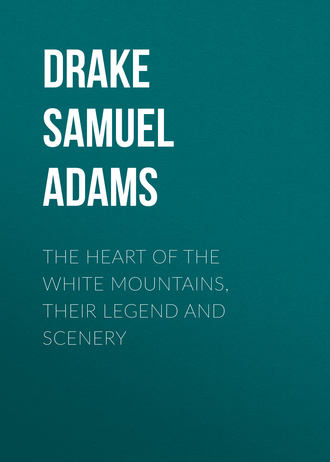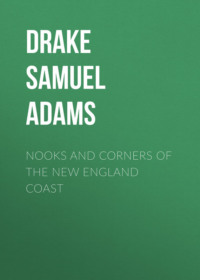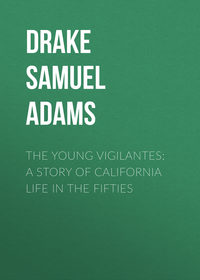 полная версия
полная версияThe Heart of the White Mountains, Their Legend and Scenery
In about an hour we reached the summit of the first mountain; for there are four subordinate ridges to cross before you stand under the single block of granite forming the pinnacle.
When reconnoitring this pinnacle through your glass, at a distance of five miles, you will say to scale it would be difficult; when you have climbed close underneath you will say it is impossible. After surveying it from the bare ledges of Bald Mountain, where we stood letting the cool breeze blow upon us, I asked my guide where we could ascend. He pointed out a long crack, or crevice, toward the left, in which a few bushes were growing. It is narrow, almost perpendicular, and seemingly impracticable. I could not help exclaiming, “What, up there! nothing but birds of the air can mount that sheer wall!” It is, however, there or nowhere you must ascend.
The whole upper zone of the mountain seems smitten with palsy. Except in the ravines between the inferior summits, nothing grew, nothing relieved the wide-spread desolation. Beyond us rose the enormous conical crag, scarred and riven by lightning, which gives to Chocorua its highly distinctive character. It is no longer ashen, but black with lichens. There was little of symmetry, nothing of grace; only the grandeur of power. You might as well pelt it with snow-balls as batter it with the mightiest artillery. For ages it has brushed the tempest aside, has seen the thunder-bolt shivered against its imperial battlements; for ages to come it will continue to defy the utmost power that can assail it. And what enemies it has withstood, overthrown, or put to rout! Not far from the base of the pinnacle evidence that the mountain was once densely wooded is on all sides. The rotted stumps of large trees still cling with a death-grip to the ledges, the shrivelled trunks lie bleaching where they were hurled by the hurricane. Many years ago this region was desolated by fire. In the night Old Chocorua, lighting his fiery torch, stood in the midst of his own funeral pyre. The burning mountain illuminated the sky and put out the stars. A brilliant circle of light, twenty miles in extent, surrounded the flaming peak like a halo; while underneath an immense tongue of forked flame licked the sides of the summit with devouring haste. The lakes, those bright jewels lying in the lap of the valleys, glowed like enormous carbuncles. Superstitious folk regarded the conflagration as a portent of war or pestilence. In the morning a few charred trunks, standing erect, were all that remained of the original forest. The rocks themselves bear witness to the intense heat which has either cracked them wide open, crumbled them in pieces, or divested them, like oysters, of their outer shell, all along the path of the conflagration.
The walk over the lower summits to the base of the peak occupied another hour, and is a most profitable feature of the ascent. On each side a superb panorama of mountains and lakes, of towns, villages, and hamlets, is being slowly unrolled; while every forward step develops the inaccessible character of the high summit more and more.
Having strayed from the path to gather blueberries, my companion set me again on the march by pointing out where a bear had been feeding not long before. Yet, while assuring me that Bruin was perfectly harmless at this season, I did not fail to remark that my guide made the most rapid strides of the day after this discovery. While feeling our way around the base of the pinnacle, in order to gain the ravine by which it is attacked, the path suddenly stopped. At the right, projecting rocks, affording a hold for neither hand nor foot, rose like a wall; before us, joined to the perpendicular rock, an unbroken ledge of bare granite, smoothly polished by ice, swept down by a sharp incline hundreds of feet, and then broke off abruptly into profounder depths. To advance upon this ledge, as steep as a roof, and where one false step would inevitably send the climber rolling to the bottom of the ravine, demands steady nerves. It invests the whole jaunt with just enough of the perilous to excite the apprehensions, or provoke the enthusiasm of the individual who stands there for the first time, looking askance at his guide, and revolving the chances of crossing it in safety. While debating with myself whether to take off my boots, or go down on my hands and knees and creep, the guide crossed this place with a steady step; and, upon reaching the opposite side, grasped a fragment of rock with one hand while extending his staff to me with the other. Rather than accept his assistance, I passed over with an assurance I was far from feeling; but when we came down the mountain I walked across with far more ease in my stockings.3
When he saw me safely over, my conductor moved on, with the remark,
“A skittish place.”
“Skittish,” indeed! We proceeded to drag ourselves up the ravine by the aid of bushes, or such protruding rocks as offered a hold. From the valley below we must have looked like flies creeping up a wall. After a breathless scramble, which put me in mind of the escalade of the Iron Castle of Porto Bello, where the English, having no scaling-ladders, mounted over each other’s shoulders, we came to a sort of plateau, on which was a ruined hut. The view here is varied and extensive; but after regaining our breath we hastened to complete the ascent, in order to enjoy, in all its perfection, the prospect awaiting us on the summit.
Like Goethe’s Wilhelm Meister, it is among mountains that my knowledge of them has been obtained. I have little hesitation, then, in pronouncing the view from Chocorua one of the noblest that can reward the adventurous climber; for, notwithstanding it is not a high peak, and cannot, therefore, unfold the whole mountain system at a glance, it yet affords an unsurpassed view-point, from which one sees the surrounding mountains rising on all sides in all their majesty, and clothed in all their terrors.
Let me try to explain why Chocorua is such a remarkable and eligible post of observation.
One comprehends perfectly that the last high building on the skirts of a city embraces the largest unobstructed view of the surrounding country. This mountain is placed at the extremity of a range that abuts upon the lower Saco valley, and therefore overlooks all the hill-country on the east and south-east as far as the sea-coast. The arc of this circle of vision extends from the Camden Hills to Agamenticus, or from the Penobscot to the Piscataqua. The day being one of a thousand, I distinctly saw the ocean with the naked eye; not merely as a white blur on the horizon’s edge, but actual blue water, over which smoke was curling. This magnificent coup-d’œil embraces the scattered villages of Conway, Fryeburg, Madison, Eaton, Ossipee, with their numerous lakes and streams. I counted seventeen of the former flashing in the sun.
In the second place, Chocorua stands at the entrance to the valley opening between the Sandwich and Ossipee chains, and commands, therefore, to the south-west, between these natural walls, the northern limb of Winnipiseogee and of Squam, which are seen glittering on each side of Red Hill. In the foreground, at the foot of the mountain, Chocorua Lake is beyond question the most enticing object in a landscape wonderfully lighted and enriched by its profusion of brilliant waters, which resemble so many highly burnished reflectors multiplying the rays of the sun. I was now looking back to my first station on Red Hill, only the range of vision was much more extensive. It is unnecessary to recapitulate the names of the villages and summits seen in this direction. Over the lakes, Winnipiseogee and Squam, the humid peaks of Mount Belknap and of Mount Kearsarge, in Warner, last caught the eye. These two sections of the landscape first meet the eye of the climber while advancing toward the peak, whose rugged head and brawny shoulders intercept the view to the north, only to be enjoyed when the mountain is fully conquered.
Upon the cap-stone crowning the pinnacle, supporting myself by grasping the signal-staff planted on the highest point of this rock, from which the wind threatened to sweep us like chaff, I enjoyed the third and final act of this sublime tableau, in which the whole company of mountains is crowded upon the stage. Hundreds of dark and bristling shapes confronted us. Like a horde of barbarians, they seemed silently awaiting the signal to march upon the lowlands. As the wind swept through their ranks, an impatient murmur rose from the midst. Each mountain shook its myriad spears, and gave its voice to swell the sublime chorus. At first all was confusion; then I began to seek out the chiefs, whose rock-helmed heads, lifted high above their grisly battalions, invested each with a distinction and a sovereignty which yielded nothing except to that imperial peak over which attendant clouds hovered or floated swiftly away, as if bearing a message to those distant encampments pitched on the farthest verge of the horizon.
At my left hand extended all the summits, forming at their western extremity the valley of Mad River, and terminating in the immovable mass of Black Mountain. The peaks of Tripyramid, Tecumseh, and Osceola stretched along the northern course of this stream, and over them gleamed afar the massive plateau-ridge of Moosehillock. From my stand-point the great wall of the Sandwich chain, which from Tamworth presents an unbroken front to the south, now divided into ridges running north and south, separated by profound ravines. Paugus crouched at my feet; Passaconnaway elevated his fine crest next; Whiteface, his lowered and brilliant front; and then Black Mountain, the giant landmark of half a score of towns and villages.
Directly at my feet, to the north-west, the great intervale of Swift River gleamed from the depths of this valley, like sunshine from a storm-cloud. Following the course of this little oasis, the eye wandered over the inaccessible and untrodden peaks of the Pemigewasset wilderness, resting last on the blue ridge of the Franconia Mountains. About midway of this line one sees the bristling slopes of Mounts Carrigain and Hancock, and the Carrigain Notch, through which a hardy pedestrian may pass from the Pemigewasset to the Saco by following the course of the streams flowing out of it. Besides its solitary, picturesque grandeur, Carrigain has the distinction of being the geographical centre of the White Mountain group. Taking its peak for an axis, a radius thirty miles long will describe a circle, including in its sweep nearly the whole mountain system. In this sense Carrigain is, therefore, the hub of the White Mountains.
Having explored the horizon thus far, I now turned more to the north, where, by a fortunate chance, Chocorua dominates a portion of the chain intervening between itself and the Saco Valley. I was looking straight up this valley through the great White Mountain Notch. There was the dark spire of Mount Willey, and the scarred side of Webster. There was the arched rock of Mount Willard, and over it the liquid profile of Cherry Mountain. It was superb; it was idyllic. Such was the perfect transparency of the air, that I clearly distinguished the red color of the slides on Mount Webster without the aid of my glass.
From this centre, outlined with a bold, free hand against the azure, the undulations of the great White Mountains ascended grandly to the dome of Mount Washington, and then plunged into the defiles of the Pinkham Notch. Following this line eastward, the eye traversed the mountains of Jackson to the half-closed aperture of the Carter Notch, finally resting on the pinnacle of Kearsarge. Without stirring a single step, we have taken a journey of three hundred miles.
Down in the valley the day was one of the sultriest; up here it was so cold that our teeth chattered. We were forced to descend into the hollow lying between the northerly foot of the peak and the first of the bald knobs constituting the great white ridge of the mountain. Here is a fine spring, and here, on either side of this singular rock-gallery, is a landscape of rare beauty enclosed by its walls. Here, too, the mutilated pyramid of the peak rises before you like an antique ruin. One finds, without effort, striking resemblances to winding galleries, bastions, and battlements. He could pass days and weeks here without a single wish to return to earth. Here we ate our luncheon, and perused the landscape at leisure. Before us stretched the long course of the Saco, from its source in the Notch to where, with one grand sweep to the east, it takes leave of the mountains, flows awhile demurely through the lowlands, and in two or three infuriated plunges reaches the sea.
I do not remember when I have more fully enjoyed the serene calm of a Sabbath evening than while wandering among the fragrant and stately pines that skirt the shores of Lake Chocorua. Indeed, except for the occasional sound of hoofs along the cool and shady road, or of voices coming from the bosom of the lake itself, one might say a perpetual Sabbath reigned here. Yonder tall, athletic pines, those palms of the north, through which the glimmer of water is seen, hum their monotonous lullaby to the drowsy lake. The mountains seem so many statues to Silence. There is no use for speech here. The mute and expressive language of two lovers, accustomed to read each others’ secret thoughts, is the divine medium. Truant breezes ruffle the foliage in playful wantonness, but the trees only shake their green heads and murmur “Hush! hush!” A consecration is upon the mere, a hallowed light within the wood. Here is the place to linger over the pages of “Hyperion,” or dream away the idle hours with the poets; and here, stretched along the turf, one gets closer to Nature, studying her with ever-increasing wonder and delight, or musing upon the thousand forms of mysterious life swarming in the clod under his hand.
Charming, too, are the walks by the lake-side in the effulgence of the harvest-moon; and enchanting the white splendor quivering on its dark waters. A boat steals by; see! its oars dip up molten silver. The voyagers troll a love-ditty. Dangerous ground this colonnade of woods and yonder sparkling water for self-conscious lovers! Love and the ocean have the same subtle sympathy with moonlight. The stronger its beams the higher rises the flood.
IV.
LOVEWELL
Of worthy Captain Lovewell I purpose now to sing.How valiantly he served his country and his king.Old Ballad.LET us make a détour to historic Fryeburg, leaving the cars at Conway, which in former times enjoyed a happy pre-eminence as the centre upon which the old stage-routes converged, and where travellers, going or returning from the mountains, always passed the night. But those old travellers have mostly gone where the name of Chatigee, by which both drivers and tourists liked to designate Conway, is going; only there is for the name, fortunately, no resurrection. No one knows its origin; none will mourn its decease.
It is here, at Conway, or Conway Corner, that first enrapturing view of the White Mountains bursts upon the traveller like a splendid vision. But we shall see it again on our return from Fryeburg. Moreover, I enjoyed this constant espionage from a distance before a nearer approach, this exchange of preliminary civilities before coming closer to the heart of the mountains.
Fryeburg stands on a dry and sandy plain, elevated above the Saco River. It lies behind the mountain range, which, terminating in Conway, compels the river to make a right angle. Turning these mountains, the river seems now to be in no hurry, but coils about the meadows in a manner that instantly recalls the famous Connecticut Ox-Bow. Chocorua and Kearsarge are the two prominent figures in the landscape.
The village street is most beautifully shaded by elms of great size, which, giving to each other an outstretched hand over the way, spring an arch of green high above, through which we look up and down. At one end justice is dispensed at the Oxford House – an inn with a pedigree; at the other learning is diffused in the academy where Webster once taught and disciplined the rising generation. A scroll over the inn door bears the date of 1763. The first school-house and the first framed house built in Fryeburg are still standing, a little way out of the village. On our way to the remarkable rock, emerging from the plain like a walrus from the sea, we linger a moment in the village graveyard to read the long inscription on the monument of General Joseph Frye, a veteran of the old wars, and founder of the town which bears his name. Ascending now the rock to which we just referred, called the Jockey Cap, we are lifted high above the plain, having the river meadows, the graceful loops of the river itself, the fine pyramid of Kearsarge on one side, and on the other the dark sheet of Lovewell’s Pond stretched at our feet.
It was here, under the shadow of Mount Kearsarge, was fought one of the bloodiest and most obstinately contested battles that can be found in the annals of war; so terrible, indeed, that the story was repeated from fireside to fireside, and from generation to generation, as worthy a niche beside that of Leonidas and his band of heroes. Familiar as is the tale – and who does not know it by heart? – it can still send the blood throbbing to the temples, or coursing back to the heart. Unfortunately, the details are sufficiently meagre, but, in truth, they need no embellishment. Their very simplicity presents the tragedy in all its grandeur. It is an epic.
In April, 1725, John Lovewell, a hardy and experienced ranger of Dunstable, whose exploits had already noised his fame abroad, marched with forty-six men for the Indian villages at Pigwacket, now Fryeburg, Maine. At Ossipee he built a small fort, designed as a refuge in case of disaster. This precaution undoubtedly saved the lives of some of his men. He was now within two short marches of the enemy’s village. The scouts having found Indian tracks in the neighborhood, Lovewell resumed his route, leaving one of his men who had fallen sick, his surgeon, and eight men, to guard the fort. His command was now reduced to thirty-four officers and men.
The rangers reached the shores of the beautiful lake which bears Lovewell’s name, and bivouacked for the night.
The night passed without an alarm; but the sentinels who watched the encampment reported hearing strange noises in the woods. Lovewell scented the presence of his enemy.
In fact, on the morning of the 8th of May, while his band were on their knees seeking Divine favor in the approaching conflict, the report of a gun brought every man to his feet. Upon reconnoitring, a solitary Indian was discovered on a point of land about a mile from the camp.
The leader immediately called his men about him, and told them that they must now quickly decide whether to fight or retreat. The men, with one accord, replied that they had not come so far in search of the enemy to beat a shameful retreat the moment he was found. Seeing his band possessed with this spirit, Lovewell then prepared for battle. The rangers threw off their knapsacks and blankets, looked to their primings, and loosened their knives and axes. The order was then given, and they moved cautiously out of their camp. Believing the enemy was in his front, Lovewell neglected to place a guard over his baggage.
Instead of plunging into the woods, the Indian who had alarmed the camp stood where he was first seen until the scouts fired upon him, when he returned the fire, wounding Lovewell and one other. Ensign Wyman then levelled his musket and shot him dead. The day began thus unfortunately for the English. Lovewell was mortally wounded in the abdomen, but continued to give his orders.
After clearing the woods in their front without finding any more Indians, the rangers fell back toward the spot where they had deposited their packs. This was a sandy plain, thinly covered with pines, at the north-east end of the lake.
During their absence, the Indians, led by the old chief, Paugus, whose name was a terror throughout the length and breadth of the English frontiers, stumbled upon the deserted encampment. Paugus counted the packs, and, finding his warriors outnumbered the rangers, the wily chief placed them in ambush; he divined that the English would return from their unsuccessful scout sooner or later, and he prepared to repeat the tactics used with such fatal effect at Bloody Brook, and at the defeat of Wadsworth. This consisted in arranging his savages in a semicircle, the two wings of which, enveloping the rangers, would expose them to a murderous cross-fire at short musket-range.
Without suspecting their danger, Lovewell’s men fell into the fatal snare which the crafty Paugus had thus spread for them. Hardly had they entered it when the grove blazed with a deadly volley, and resounded with the yells of the Indians. As if confident of their prey, they even left their coverts, and flung themselves upon the English with a fury nothing could withstand.
In this onset Lovewell, who, notwithstanding his wound, bravely encouraged his men with voice and example, received a second wound, and fell. Two of his lieutenants were killed at his side; but with desperate valor the rangers charged up to the muzzles of the enemy’s guns, killing nine, and sweeping the others before them. This gallant charge cost them eight killed, besides their captain; two more were badly wounded.
Twenty-three men had now to maintain the conflict with the whole Sokokis tribe. Their situation was indeed desperate. Relief was impossible; for they were fifty miles from the nearest English settlements. Their packs and provisions were in the enemy’s hands, and the woods swarmed with foes. To conquer or die was the only alternative. These devoted Englishmen despaired of conquering, but they prepared to die bravely.
Ensign Wyman, on whom the command devolved after the death of Lovewell, was his worthy successor. Seeing the enemy stealing upon his flanks as if to surround him, he ordered his men to fall back to the shore of the lake, where their right was protected by a brook, and their left by a rocky point extending into the lake. A few large pines stood on the beach between.
This manœuvre was executed under a hot fire, which still further thinned the ranks of the English. The Indians closed in upon them, filling the air with demoniac yells whenever a victim fell. Assailing the whites with taunts, and shaking ropes in their faces, they cried out to them to yield. But to the repeated demands to surrender, the rangers replied only with bullets. They thought of the fort and its ten defenders, and hoped, or rather prayed, for night. This hope, forlorn as it seemed, encouraged them to fight on, and they delivered their fire with fatal precision whenever an Indian showed himself. The English were in a trap, but the Indians dared not approach within reach of the lion’s claws.
While this long combat was proceeding, one of the English went to the lake to wash his gun, and, on emerging at the shore, descried an Indian in the act of cleansing his own. This Indian was Paugus.
The ranger went to work like a man who comprehends that his life depends upon a second. The chief followed him in every movement. Both charged their guns at the same instant. The Englishman threw his ramrod on the sand; the Indian dropped his.
“Me kill you,” said Paugus, priming his weapon from his powder-horn.
“The chief lies,” retorted the undaunted ranger, striking the breech of his firelock upon the ground with such force that it primed itself. An instant later Paugus fell, shot through the heart.
“I said I should kill you,” muttered the victor, spurning the dead body of his enemy, and plunging into the thickest of the fight.
Darkness closed the conflict, which had continued without cessation since ten in the morning. Little by little the shouts of the enemy grew feebler, and finally ceased. The English stood to their arms until midnight, when, convinced that the savages had abandoned the sanguinary field of battle, they began their retreat toward the fort. Only nine were unhurt. Eleven were badly wounded, but were resolved to march with their comrades, though they died by the way. Three more were alive, but had received their death-wounds. One of these was Lieutenant Robbins, of Chelmsford. Knowing that he must be left behind, he begged his comrades to load his gun, in order that he might sell his life as dearly as possible when the savages returned to wreak their vengeance upon the wounded.









